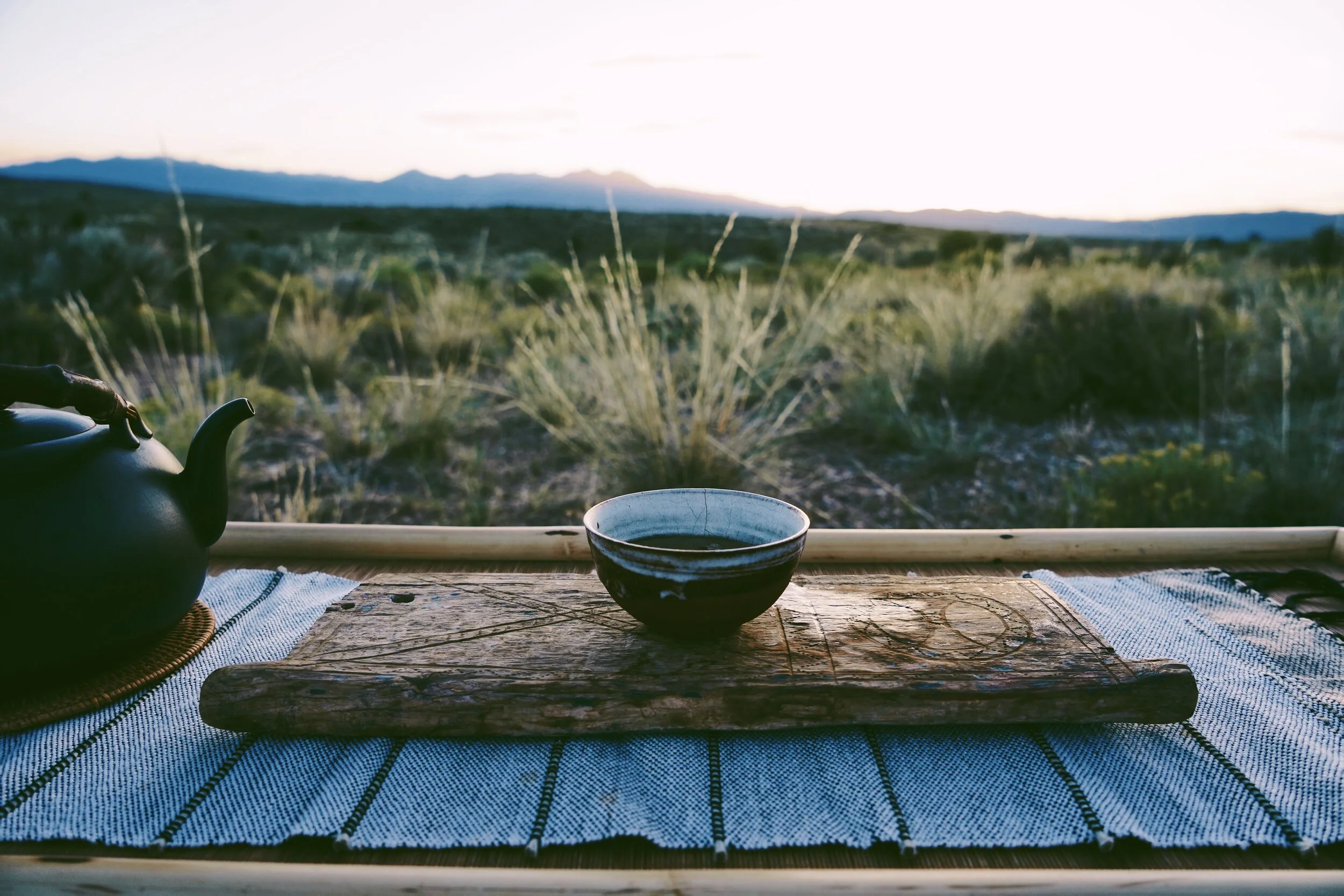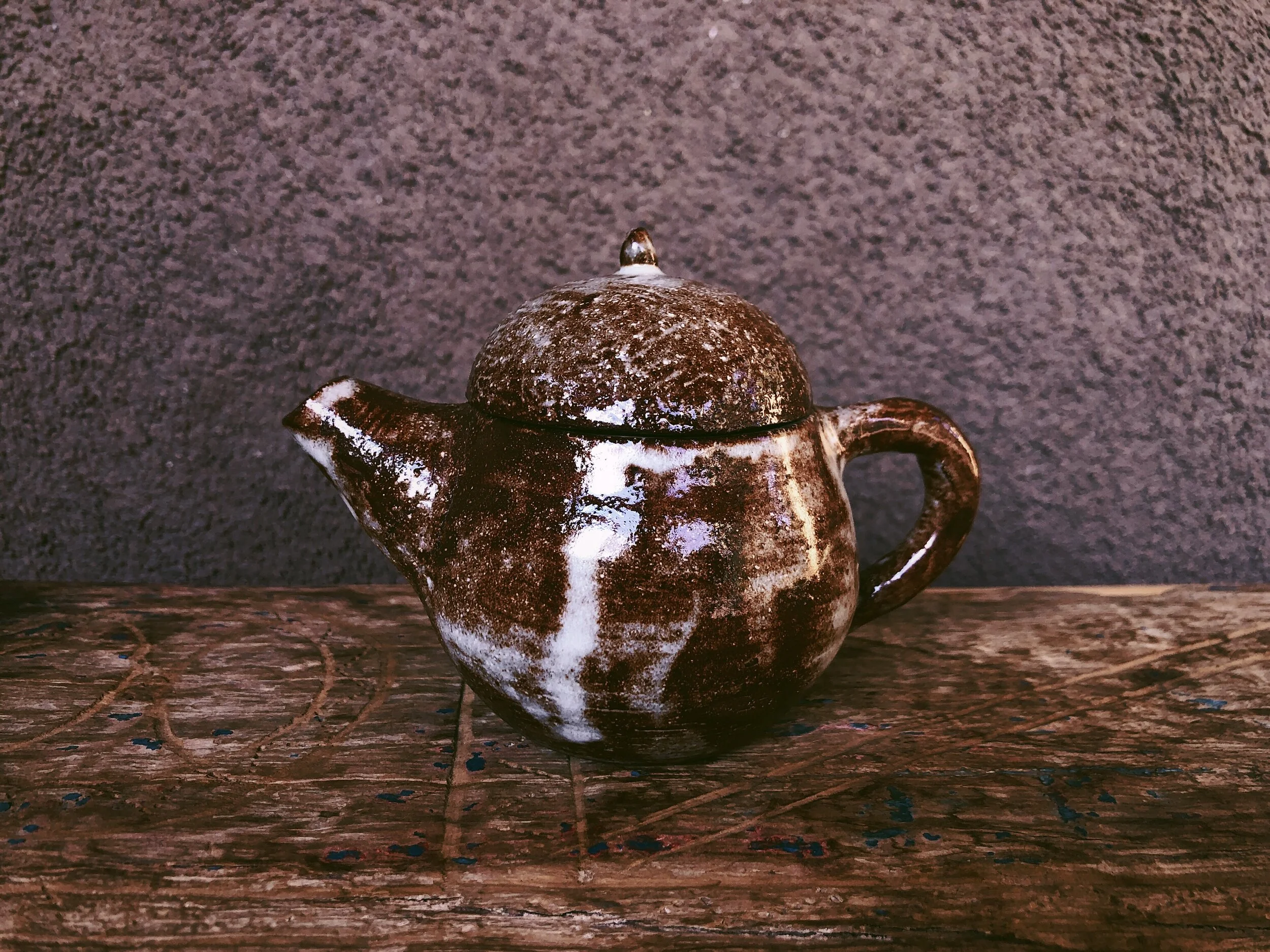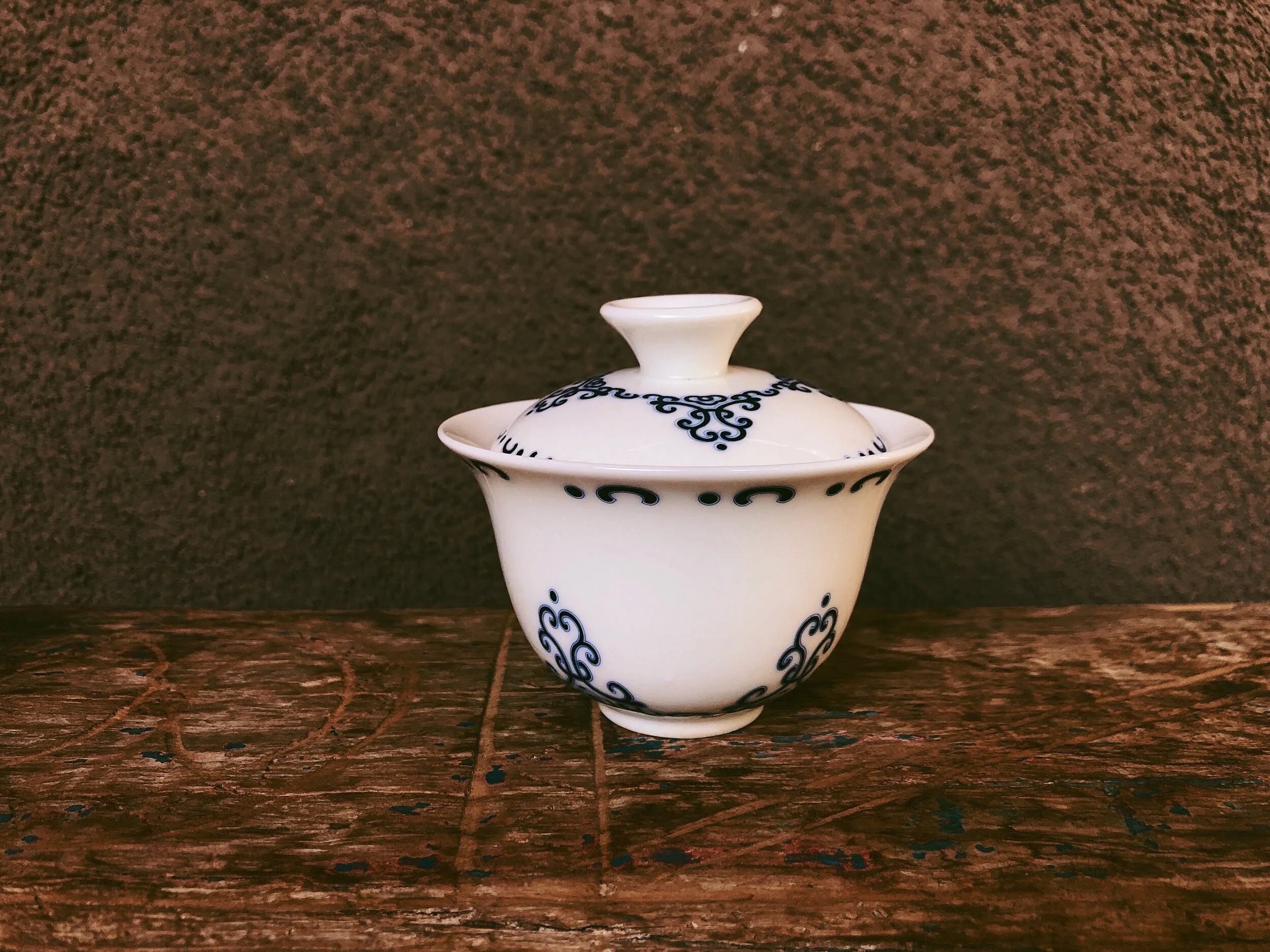Chapter 1
-
-
How to explore Chapter 1
In this chapter, we will be exploring the story of tea, the tea plant, the original carriers, the different waves of the story, the evolution of the practice, from the origin to modern day tea.
You may want to start this chapter by exploring the audio theory “Chapter 1 - The Story of Tea” below, then support your exploration through the written theory and photos. Our tea exploration for this chapter will be a minimalist tea practice that you can explore, with minimal tools. You will find a video demonstrating the ritual at the end of this chapter, followed by a guided audio tea meditation.
葉 for leaf, grass
人 for people
木 for tree, wood
Tea is nothing less than a collaboration between Nature and Culture.
When we follow this way,
we remember the importance of protecting both ;
Nature and Culture.
According to a legend, tea was discovered by the legendary Chinese emperor and herbalist, Shennong, around 3000 BCE. His name Shénnóng, can be translated as the Divine Farmer or Agriculture God. He was considered a carrier of herbal medicine and the practice of agriculture, recognized to have created many agricultural tools, the Chinese calendar, and to have refined many aspects of Chinese medicine. Shénnóng had the ritual of boiling his water before drinking, to purify it. One day, he went on a journey to explore distant regions, accompanied by his army. During one of their break moment, one of his assistant offered to boil some water for him to drink. Shénnóng was resting, meditating with his bowl of boiled water, sitting against a tree in the forest, when suddenly, leaves from one of the tree fell into his bowl. The tree was a wild tea tree. Shénnóng was touched by the infusion of the leaves in the water, and compelled to explore the plant, known today as Camellia Sinensis. While Shénnóng was exploring the medicine of plants, it said that he encountered many poisonous ones, and that the leaves of the tea plant would be used as an antidote to heal.
We will explore more about the name / names of this plant, as we move through the journey.

The leaves of the plant are used for medicinal purposes.
The leaves are sometimes added to a stew of butter, salt, onions and spices.
During this period, tea drinking evolved into a more artistic ritual. Tea was compressed into brick to be preserved longer, and was made by breaking a piece of the brink, grinded into a powder and boiled in water with salt.
The book of Lu Yu “Cha Jing” or “Classic of Tea”, is covering everything related to tea during that time, from the proper techniques to growing plants to brewing tea. In the book, there is a detailed description of the formal tea ritual of the time, requiring 27 tools. Since the practice of tea was new and complexe during this period, only the emperor, members of the royal family, important artists or affluent connoisseurs - could afford all the equipment required to prepare tea. During this era, only green tea or eventually pu’er tea (fermented tea from Yunnan) was discovered. During the Tang Dynasty, tea was possibly mainly served in a bowl, appreciated for its medicinal values and poetic aura.
Due to the rising influence of buddhism in China during this period, the ritual of tea became more minimal, simple, and the plant was considered to be a spiritual ally. Harvest also became carefully regulated. Tea leaves were picked by hands, by women, in a ritualistic manner.
Tea was prepared in a powdered form. Water was added on top of the powder in a bowl, and whipped with a bamboo whisk, in a similar way that matcha is prepared in Japan today. Matcha, or “powdered tea”, came from China. Japanese monks discovered this practice, while traveling to China, between the 8-10th centuries. They eventually brought the practice of tea to Japan.
During this era, an important trading route was also built, known as the Tea Horse Road. Tea was now traded beyond the borders of China. The Tea Horse Road was connecting the South of China to the high plateau of Tibet and eventually to Mongolia, and to the West. The initial intention of the Chinese was to trade tea for Tibetan horses, to defend the country against invasions. This part of history also allowed the discovery of hei cha (aged fermented tea), like Pu’er, and eventually Liu bao, Liu an, Fu Zhuan, produced mainly for exportation, along the tea horse road.
During the Sung Dynasty, Tea was served in a bowl, appreciated for its spiritual essence and meditative values.
During this era, tea became a more vast and accessible experience. Tea was now shared in the form of loose leaves, and steeped into vessels. This period gave birth to the creation of different types of vessels and tools for tea, the practice of gongfu cha in China and eventually the practice of senchado in Japan. Along the journey, the carrier of this practice discovered different processes to transform the leaves, which gave birth to different types of tea ; oolong, red tea, yellow tea and white tea.
The first westerners to have discovered tea are Portuguese priests and merchants in China during the 16th century. The first written mention of tea in the west was from the Italian Gaimbattista Ramusio in 1545, in his book « Voyages and Travels », who shared about the health benefits of tea, that he discovered while traveling to Asia. During this period, tea consumption spread throughout Europe, Africa and the rest of Asia. The first shipments of tea in the west was in the 17th century by the Dutch East India Company. In the 18th century, there were many attempts from the British to colonize tea, trying to uncover the secret of tea in China, with the intention to start producing tea on the land of India. Unable to obtain the secret, they introduced Opium into China, in the hope to use it as a currency to trade in exchange of the secret of tea and tea trees. The British later discovered wild tea trees endemic to the region of Assam, similar to the larger tea trees of Yunnan, China. Unfortunately, the colonization of the land transformed the ecosystem, affecting most of the original and ancient tea trees of the land of India, replaced by younger trees.
Many regions of the world are now growing the plant Camellia Sinensis. Tea is the most popular beverage in the world, after water. It is important to remember that the plant Camellia Sinensis was only originally endemic of the land of China and India. In chapter 2, we will explore the impact of the production and industry of tea, and how we can source tea in a conscious, ethical and mindful way, to support nature.

Cha Hu (teapot) - for the ritual of Gong Fu Cha

Gaiwan - for the ritual of Gong Fu Cha

Hohin - For the ritual of Senchado
We will be exploring tea vessels & tools, as we explore the ritual of gongfu cha in chapter 4, and the ritual of senchado in chapter 5.
For many ethnic groups of China (Bulang, Dai, Yi, Hani, etc) the ritual of tea is deeply animistic, rooted in their guardianship of ancient tea trees. Most ethnic groups of Yunnan are sharing tea in communal settings, as a part of hospitality, or as part of shamanistic traditions. The tools used by many groups of China for tea, such as the Bulang people, are sometimes very simply, such as large wooden bowls, focusing more on ancestral gratitude than on aesthetic precision and flavor refinement.
For the Bulang people of Yunnan, sharing tea is a way to honor, pay respect to and revere their ancestor Pa'Ailong, considered the mythological or ancestral figure who first brought tea cultivation to the Bulang people. The Bulang believe that tea is a sacred gift passed down through generations by Pa'Ailong, and they continue to honor him through rituals and ceremonies.
May we remember that there are as many “way of tea” (or “ways of connecting to tea”) as there are people and communities drinking tea in China, and all across tea culture, beyond China.
We start this journey by exploring the simplicity of infusing our tea leaves in a bowl. All you need is water, tea leaves, and a small bowl (about the size of a rice bowl). To infuse your tea leaves in a bowl will allow you to connect to the dance of Water and Leaves, with all of your senses, as you notice the leaves unfolding and returning to life in the water, giving birth to tea. To practice tea in a bowl will allow you to connect to the essential ; water and leaves, infusing into mindful presence.
*Please note that this video is the only video available outside of this course. I have shared it on my public YouTube channel. The rest of the video content shared in this course was created to remain dedicated and private to the online platform.
MEDITATING WITH TEA LEAVES IN A BOWL
For this meditation, all you need is boiled water, your tea leaves and a tea bowl. Add your leaves into your bowl, pour hot water on top, let your leaves steep in your bowl for 50 seconds, and receive your tea in silence. When you are ready, you can listen to the audio file “TEA MEDITATION”, as we share the last part of this chapter together, an exploration of the ritual of tea as a meditation practice.
TEA COURSE PACKAGE
If you are supporting your practice with the tea course package, for this chapter, we explore Vesta Purple Tea 紫芽, from naturally mutated purple leaf Camellia Sinensis var. Assamica tree endemic of Lincang forest, Yunnan, China. Lincang is known to have the most ancient tea trees in the world. The leaves of this tea were harvested from wild indigenous trees of more than 150 years old.
This region is known for its precious rich biodiversity. The buds and leaves of this varietal of tea tree are of distinctive purple/burgundy color, caused by the presence of the powerful antioxidant Anthocyanin in the plant, which is responsible for giving the purple/blue color to certain types of fruit, like cherry, blackberry, blueberry, juniper berry, plum or red grapes. This purple pigment antioxidant is offering a myriad of health benefits; such as antibacterial activity, vasodilatory, anti-inflammatory, antiallergic and antiviral.
Because the purple bud varietal is rare, any tea that are made from these leaves are incredible precious for tea lovers. The special bud of this tea is used to produce pu’er tea or "black" tea if fully oxidized.
The story of Tea
Chapter 2
Theory of Chapter 2
Theory of Chapter 3
Gong Fu Cha Theory
Theory of Japanese Tea History
Creating your Tea Offering
Ritual beyond the Ritual